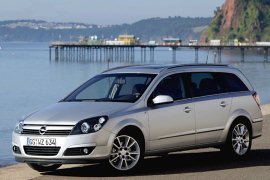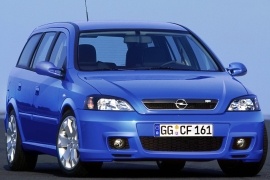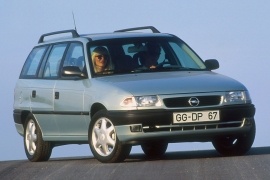OPEL Astra Caravan Models/Series Timeline, Specifications & Photos
First production year: 1994
Engines: Diesel, Gasoline
Body style: Wagon (station wagon, estate, combi, touring)
Opel introduced the Astra H station wagon a few months after its five-door sibling in late 2004 and offered customers an improved experience compared with its predecessor, the Astra G.
By 2004, the Astra was already a popular vehicle on the European market. Its stiffer suspensions and low maintenance costs transformed it into an excellent rental vehicle. In addition, it was an excellent all-rounder, family-oriented car. It wasn't as passionate as the Astra GTC or just a tool as the Astra hatchback. But it had everything a driver needed and a family desired. In addition, it was priced lower or similar to its competitors.
The station wagon featured the same front fascia up to the B-pillars with the 5-door hatchback version. An upper slat on the radiator's grille and the round, chromed Opel badge in the middle covered the front area, flanked by the bio-design-inspired headlights. The overall design was a mix between a cubist style and a rounded one. The tailgate was wide and tall, providing easy access to the loading area.
Inside, the straight and simple dashboard featured an option for an onboard computer in the middle of the front area. The information and entertainment center controls were placed on the center stack, on a rotary knob, and on a few buttons. The rear split-folding bench in 60/40 proportions allowed owners to extend the trunk volume of up to 1,550 liters (54.7 cu-ft), which was among the best in its segment.
The Astra was offered a wide choice of gasoline and diesel engines. The most attractive was the 1.9-liter diesel, which offered enough grunt and great fuel efficiency with a standard, 5- or 6-speed gearbox and an option for a 6-speed auto. The Astra H hatchback scored some of the highest sales in its segment.
OPEL Astra Caravan 1.4L 16V 5MT FWD (90 HP)
OPEL Astra Caravan 1.6L 16V 5AT FWD (105 HP)
OPEL Astra Caravan 1.6L 16V 5MT FWD (105 HP)
OPEL Astra Caravan 1.8L 16V 4AT FWD (125 HP)
OPEL Astra Caravan 1.8L 16V 4AT FWD (140 HP)
OPEL Astra Caravan 1.8L 16V 5MT FWD (125 HP)
OPEL Astra Caravan 1.8L 16V 5MT FWD (140 HP)
Opel tried and offered a sporty version of its Astra Caravan (station wagon) in 2002, introducing a turbocharged gasoline engine under the car's hood.
Most families need a station wagon to carry them in and around towns. They are also using the same vehicle for long travels. A compact vehicle could do that very well, but usually with limited trunk space. If there is more than one kid involved in the process, then a regular hatchback is not enough. Opel thought an OPC version for a station wagon could do a better job and built it in 2002.
The most potent Astra station wagon featured a redesigned front fascia. While it retained the same headlights, it sported a new wrapped-around front bumper with a wider lower air-dam and two fog lights in squared clusters. A pair of aerodynamically profiled door mirrors adorned the car's sides. At the back, the carmaker installed a roof spoiler on top of the liftgate.
Inside, the carmaker installed an enhanced instrument cluster with white dials. The changed interior went further, with an OPC badge on the center console and sport bucket seats and side bolstering good enough to provide decent support during high-speed cornering. At the back, the carmaker installed the same bench as on the regular Astra Caravan (station wagon) but with different upholstery. Its flat-folding rear bench expanded the trunk size from 460 liters (15.2 cu-ft) to 1,500 liters (13.7 cu-ft).
Under the hood, OPC (Opel Performance Center) installed a turbocharged 2.0-liter engine, which provided 200 hp. The carmaker paired it with a five-speed manual and provided decent performances for its segment.
Opel was riding the high tides in the late '90s and kept the momentum when it introduced the second generation of the Astra.
For the European compact segment, the Astra was on its second generation, although it was previously known as the Kadett. Nevertheless, the vehicle was not only known but also appreciated for its robust construction and low price. In addition, it was also available as a station wagon, and that transformed it into an excellent family vehicle.
The 1998 Astra lineup, or Astra G, was an important step forward in Opel's design language. Not only that the car finally lost the previously used small headlights, but it also sported a nice grille integrated into the front side of the hood. From its profile, the long roof version featured the same front doors as its five-door hatchback sibling, but the rear ones were redesigned. In addition, the automaker added a third row of windows next to the trunk area and a straight-up D-pillar at the back. Finally, the tailgate was flanked on the sides by the taillights.
Inside, the base trim level received just basic features. The power windows and locks, the sound system, and the AC were only available either as an option or fitted as standard for the higher-powered versions. At the front, the carmaker included a pair of bucket seats, while at the back was a split-folding bench fit for three adults. Thanks to the folding mechanism, the trunk area could've been expanded from 480 liters (17 cu-ft) to 1,500 liters (53 cu-ft).
Under the hood, Opel installed a wide choice of gasoline and turbo-diesel engines paired mostly with a five-speed manual. Depending on engine choice, the carmaker also offered a four-speed automatic.
OPEL Astra Caravan 1.2L 16V 5MT FWD (65 HP)
OPEL Astra Caravan 1.6L 16V 4AT FWD (100 HP)
OPEL Astra Caravan 1.6L 16V 5MT FWD (100 HP)
OPEL Astra Caravan 1.6L 4AT FWD (75 HP)
OPEL Astra Caravan 1.6L 4AT FWD (85 HP)
OPEL Astra Caravan 1.6L 5MT FWD (75 HP)
OPEL Astra Caravan 1.6L 5MT FWD (85 HP)
OPEL Astra Caravan 1.8L 16V 4AT FWD (115 HP)
OPEL Astra Caravan 1.8L 16V 4AT FWD (125 HP)
OPEL Astra Caravan 1.8L 16V 5MT FWD (115 HP)
OPEL Astra Caravan 1.8L 16V 5MT FWD (125 HP)
OPEL Astra Caravan 2.0L 16V 4AT FWD (136 HP)
OPEL Astra Caravan 2.0L 16V 5MT FWD (136 HP)
When Opel refreshed the Astra lineup in 1994, it improved the engine lineup and the safety features and made some aesthetic upgrades for all versions, including the station wagon.
The first generation of the Astra was already a big hit in 1994. The German automaker faced a huge success on the market and was already biting a part of the Golf's slice. But Opel didn't stop improving the vehicle. Instead, it kept the momentum and pushed even harder.
For the facelifted version, Opel created a new front fascia that sported a redesigned grille with a reversed trapezoidal shape where the carmaker's badge took center stage. But changes went even further, and the corner-mounted blinkers got clear lenses instead of orange ones as on the 1991 Astra. In addition, the car's profile showed the same long-roof shape fitted with two doors on each side. Some people hoped that after the facelift, the carmaker would return the three-door station wagon shape to the market, as it was on the Kadett. Yet, that didn't happen. Finally, at the back, the Astra Caravan featured smoked lenses for the taillights.
Inside, the carmaker installed a redesigned dashboard with an airbag for the side passenger. In addition, the driver got a standard airbag on the new, four-spoke steering wheel. For the sound system, Opel offered an option for a CD player for the top trim levels, while the base version remained without any radio. The rear folding rear bench increased the trunk space from 500 liters (17.7 cu-ft) to 1,630 liters (57.6 cu-ft).
Under the hood, the carmaker introduced new Euro 2-compliant engines. The base version featured a 1.4-liter that provided just 60 hp, but on the other end of the scale was a 2.0-liter, 136-hp version.
OPEL Astra Caravan 1.4i 5MT FWD (60 HP)
OPEL Astra Caravan 1.6i 16V 4AT FWD (100 HP)
OPEL Astra Caravan 1.6i 16V 5MT FWD (100 HP)
OPEL Astra Caravan 1.6i 4AT FWD (71 HP)
OPEL Astra Caravan 1.6i 4AT FWD (75 HP)
OPEL Astra Caravan 1.6i 5MT FWD (71 HP)
OPEL Astra Caravan 1.6i 5MT FWD (75 HP)
OPEL Astra Caravan 1.8i 16V 4AT FWD (115 HP)
OPEL Astra Caravan 1.8i 16V 5MT FWD (115 HP)



